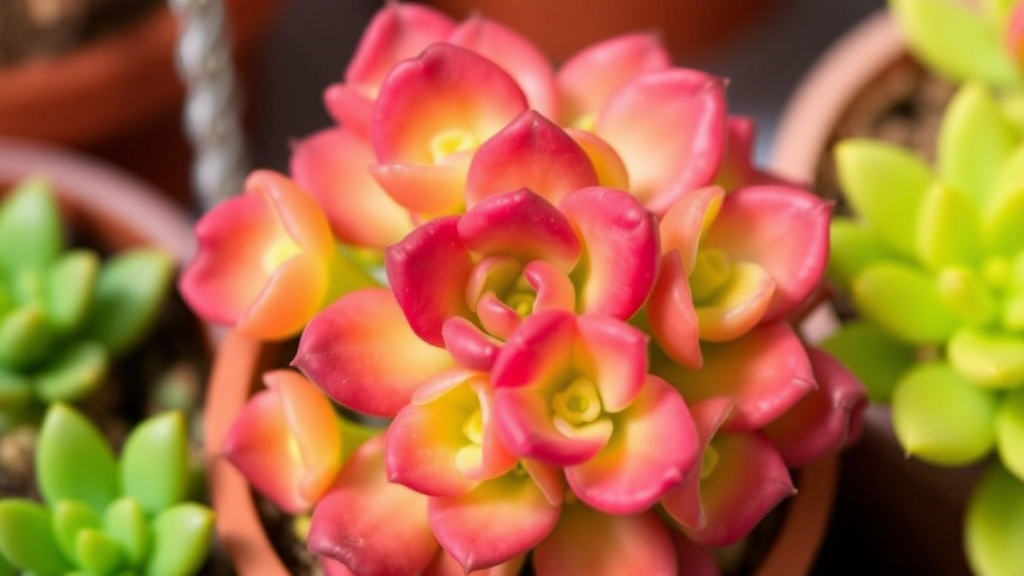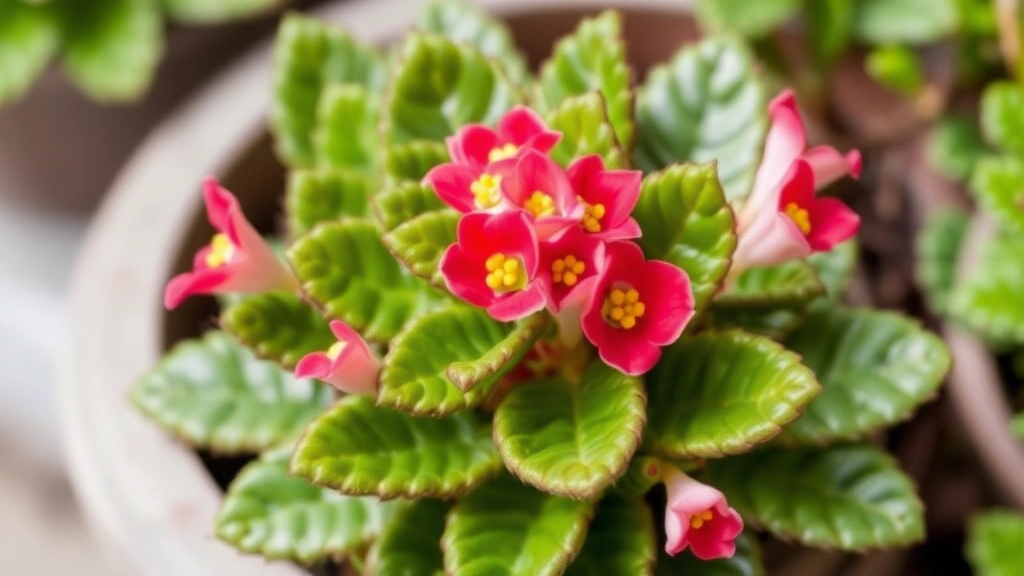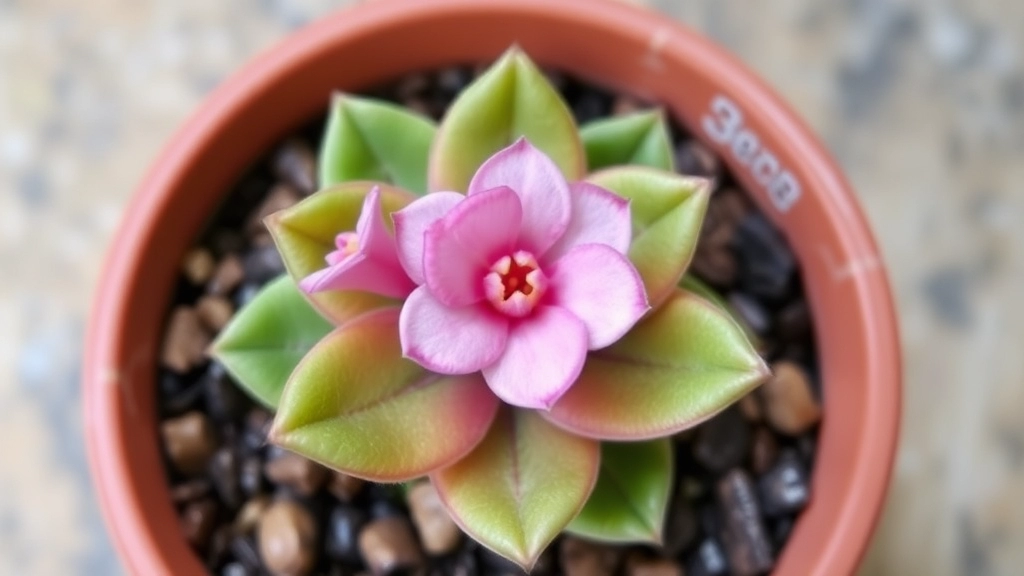Kalanchoe Beharensis Furless
If you’re looking to add a unique touch to your garden, the Kalanchoe Beharensis Furless is a standout choice. Unlike its velvety counterparts, this variety boasts smooth, toothed blue leaves that can grow up to 4 feet tall and 5 feet wide. It’s perfect for both garden beds and containers, thriving in full sun to partial shade and well-drained soil.
Low-Maintenance Nature
One of the most striking features of the Kalanchoe Beharensis Furless is its low-maintenance nature. With minimal watering and the right light conditions, this succulent can become a focal point in any garden. Whether you’re a seasoned gardener or just starting out, this plant offers a visually appealing and easy-to-care-for option.
Are you curious about what makes Kalanchoe Beharensis Furless stand out in the world of succulents?
This remarkable plant, often referred to as the “Furless Kalanchoe,” boasts several distinctive features that capture the eye and spark interest.
**Physical Appearance**
– **Leaves**: The leaves are large, paddle-shaped, and can grow up to 30 cm long. Their unique grey-green hue gives them a striking appearance.
– **Height**: This succulent can reach heights of up to 1 meter, making it a bold choice for indoor or outdoor spaces.
– **Growth Habit**: It typically exhibits an upright growth pattern, adding vertical interest to your plant collection.
**Unique Traits**
– **Texture**: Unlike many succulents, the Kalanchoe Beharensis Furless has a smooth surface, devoid of the fuzzy or hairy textures found in other varieties.
– **Flowers**: While not its primary attraction, it can produce clusters of small, tubular flowers, usually in shades of yellow or orange, during the blooming season.
– **Drought Resistance**: As a succulent, it is well-adapted to arid conditions, making it a low-maintenance option for busy plant enthusiasts.
For more expert tips on caring for this unique plant, check out our [Kalanchoe Beharensis Care Guide](https://planthq.org/care-and-propagation-of-kalanchoe-beharensis-tree/). Additionally, if you are interested in other varieties, our comprehensive guide on [Types of Kalanchoe Tomentosa](https://planthq.org/types-of-kalanchoe-tomentosa-varieties-and-care-tips/) might be helpful.
Optimal Light and Temperature Conditions

So, you’ve got your Kalanchoe Beharensis Furless, and you’re wondering how to keep it thriving, right?
Light Needs:
This plant loves the sun but isn’t a fan of scorching heat. Here’s how to strike that perfect balance:
- Bright, Indirect Light: Place it near a window where it can soak up the sun without getting burnt.
- Avoid Direct Sunlight: Too much can lead to leaf scorch. Think of it like a sunbather needing a good hat!
Temperature Preferences:
Kalanchoe Beharensis Furless is quite the diva when it comes to temperature:
- Ideal Range: Aim for 20-25°C (68-77°F) during the day. It’s like the comfy zone for your plant.
- Nighttime Chill: A drop to around 10-15°C (50-59°F) at night is totally fine. Just don’t let it dip below 5°C (41°F) – that’s a no-go!
Humidity Levels:
This succulent isn’t picky about humidity, but it does prefer a drier environment:
- Low to Moderate Humidity: It thrives in typical home humidity, so no need for fancy humidifiers here.
Soil Requirements and Watering Practices
As we delve deeper into the care of Kalanchoe Beharensis Furless, understanding its soil and watering needs is crucial for maintaining a healthy plant.
Soil Requirements
Kalanchoe Beharensis Furless thrives best in well-draining soil. Here’s what you should consider:
- Potting Mix: A cactus or succulent potting mix is ideal. This type of mix allows excess water to flow away, preventing root rot.
- DIY Mix: If you prefer to create your own, combine equal parts of potting soil, coarse sand, and perlite. This mixture ensures aeration and drainage.
- pH Level: Aim for a slightly acidic to neutral pH (around 6.0 to 7.0). This range supports optimal nutrient uptake.
Watering Practices
Watering is an art, especially with succulents like Kalanchoe Beharensis Furless. Here are some key tips:
- Frequency: Water every 2-3 weeks during the growing season (spring and summer). In autumn and winter, reduce to once a month.
- Method: Use the âsoak and dryâ method. Water thoroughly until it drains from the bottom, then allow the soil to dry out completely before the next watering.
- Signs of Overwatering: Yellowing leaves or mushy stems indicate overwatering. Adjust your schedule accordingly.
- Humidity: This plant prefers low humidity. Avoid misting, as it can lead to fungal issues.
By ensuring the right soil and watering practices, your Kalanchoe Beharensis Furless will flourish. For more tips on optimal care, check out our Kalanchoe Tomentosa care guide and learn about the best soil for Kalanchoe Blossfeldiana.
Propagation Techniques for Kalanchoe Beharensis Furless

When considering how to expand your collection of Kalanchoe Beharensis Furless, you might wonder about the best propagation methods. This succulent is not only stunning but also relatively easy to propagate, making it a rewarding plant for enthusiasts and beginners alike.
Methods of Propagation
- Leaf Cuttings:
- Select healthy leaves from the parent plant.
- Allow the cut ends to dry for a few days until a callous forms.
- Place the leaf in well-draining soil, burying the cut end slightly.
- Water sparingly until new growth appears.
- Offsets:
- Kalanchoe Beharensis often produces offsets or pups.
- Gently remove these offsets from the base of the parent plant.
- Let them dry for a day to form a callous.
- Plant them in a suitable soil mix and water lightly.
- Stem Cuttings:
- Cut a healthy stem, ideally 4-6 inches long.
- Allow the cut end to dry and callous.
- Plant the cutting in well-draining soil and water sparingly until roots develop.
Tips for Successful Propagation
- Timing: Early spring is the best time for propagation, as the plant is actively growing.
- Environment: Ensure a warm, bright location with indirect sunlight to encourage rooting.
- Humidity: Maintain moderate humidity levels; a plastic bag can help retain moisture for cuttings.
By following these straightforward techniques, you can easily propagate Kalanchoe Beharensis Furless and enjoy more of these beautiful plants in your home or garden.
Common Pests and Diseases
When caring for Kalanchoe Beharensis Furless, encountering pests and diseases can be a source of concern for many plant enthusiasts. Understanding how to identify and manage these issues is crucial for maintaining the health of your plant.
Indoor Care Tips for Kalanchoe Beharensis Furless

So, you’ve got your Kalanchoe Beharensis Furless and you’re wondering how to keep it thriving indoors?
Let’s dive into some straightforward care tips that’ll make your plant happy and healthy.
Light Requirements
- Bright, Indirect Light: Place your Kalanchoe near a window where it can soak up bright, indirect sunlight. Too much direct sun can scorch those lovely leaves.
- Rotate Regularly: Give it a little spin every now and then to ensure even growth. Trust me, it’ll thank you!
Temperature Needs
- Ideal Range: Aim for a cozy 18-24°C (65-75°F). This plant isn’t a fan of chilly drafts or sudden temperature changes.
- Avoid Frost: If you live in a colder area, make sure it’s not exposed to frost. Bring it inside if the temperatures drop!
Watering Practices
- Let It Dry: Kalanchoe prefers to dry out between waterings. Stick your finger in the soil; if it’s dry an inch down, it’s time for a drink.
- Water Sparingly: Overwatering is a common mistake. Less is more with this plant!
Humidity Levels
- Low Humidity: Kalanchoe Beharensis Furless thrives in low humidity, making it perfect for indoor environments. No need to mist!
Fertilising
- Feed Sparingly: Use a diluted succulent fertilizer during the growing season (spring and summer). Just once a month is enough.
Uses in Garden Design
When considering how to incorporate Kalanchoe Beharensis Furless into your garden design, you might wonder about its versatility and aesthetic appeal.
Kalanchoe Beharensis Furless, with its striking architectural form and unique foliage, serves as a fantastic focal point in various garden settings.
Key Design Applications
- Succulent Gardens: This plant thrives alongside other succulents, creating a stunning display of textures and colours.
- Rock Gardens: Its drought-resistant nature makes it perfect for rock gardens, where it can add height and interest.
- Container Planting: Kalanchoe Beharensis Furless looks fabulous in pots, allowing you to move it around to find the perfect spot for sunlight.
- Tropical Themes: Pair it with other tropical plants to create a lush, exotic atmosphere in your garden.
- Mixed Borders: Use it in mixed borders to add drama and contrast with flowering plants and shrubs.
Design Tips
- Height Variation: Position Kalanchoe Beharensis Furless at the back of beds to create depth.
- Colour Coordination: Consider pairing it with plants that have complementary colours for a cohesive look.
- Seasonal Interest: Incorporate seasonal flowers around it to ensure year-round visual appeal.
Seasonal Care and Maintenance for Kalanchoe Beharensis Furless

So, you’ve got your Kalanchoe Beharensis Furless thriving, but how do you keep it looking its best throughout the seasons?
Seasonal Changes Matter
Each season brings its own set of challenges and opportunities for your plant. Here’s what to keep in mind:
Spring
- Repotting: This is the perfect time to repot if your plant has outgrown its pot. Choose a slightly larger pot with good drainage.
- Fertilising: Start feeding with a diluted succulent fertiliser every few weeks to boost growth.
- Watering: Increase watering as temperatures rise, but always check the soil moisture first.
Summer
- Heat Management: If it’s sweltering, ensure your plant isn’t getting scorched. A little shade during the hottest part of the day can go a long way.
- Pest Watch: Keep an eye out for pests like mealybugs, which love the warm weather. A quick inspection can save you a headache later.
Autumn
- Watering Adjustments: As temperatures drop, reduce watering. Your plant will need less moisture as it prepares for dormancy.
- Pruning: This is a good time to trim back any leggy growth. It’ll help your plant conserve energy for the winter.
Winter
- Light Needs: Ensure your Kalanchoe gets plenty of bright, indirect light. If it’s looking a bit sad, consider moving it closer to a window.
- Temperature Checks: Keep it in a warm spot, away from drafts. Ideally, it should be between 15-21°C (60-70°F) to keep it happy.
General Tips for Seasonal Care
- Keep an Eye on Humidity: Kalanchoe Beharensis prefers drier air. If you notice any signs of rot, it might be too humid.
- Be Mindful of Watering: Always let the soil dry out between waterings, especially in winter.
Safety Precautions Around Pets and Children
When considering the beauty of Kalanchoe Beharensis Furless, it’s essential to keep in mind the safety of our furry friends and little ones.
Understanding the Risks
Kalanchoe plants can be toxic to pets and children if ingested.
- Common Symptoms of Ingestion:
- Vomiting
- Diarrhoea
- Lethargy
- Drooling
Safety Tips
To ensure a safe environment, here are some practical precautions:
- Placement Matters: Keep Kalanchoe Beharensis out of reach of pets and children. High shelves or hanging pots can be effective.
- Educate Family Members: Teach children about the importance of not touching or tasting plants without asking an adult.
- Use Barriers: Consider using decorative barriers or plant stands to create a physical distance.
- Monitor Interactions: Always supervise pets and young children when they are near your plants.
Alternatives for Pet Owners
If you have pets that are prone to nibbling on plants, consider non-toxic alternatives. Some safe options include:
- Spider plants
- Boston ferns
- Bamboo palm
By being proactive, you can enjoy the beauty of Kalanchoe Beharensis while ensuring a safe home for everyone. For more detailed care tips, check out our Kalanchoe Beharensis care guide. Additionally, learn how to protect your pets from potential risks with our Kalanchoe Tomentosa toxicity guide.
FAQs for Kalanchoe Beharensis Furless
What type of light does Kalanchoe Beharensis Furless need?
Kalanchoe Beharensis Furless thrives in bright, indirect light. It’s best to place it near a window where it can enjoy sunlight without being exposed to direct rays, which can cause leaf scorch.
What are the ideal temperature conditions for Kalanchoe Beharensis Furless?
This plant prefers temperatures between 20-25°C (68-77°F) during the day and can tolerate a drop to 10-15°C (50-59°F) at night. Avoid letting the temperature fall below 5°C (41°F).
How should I water my Kalanchoe Beharensis Furless?
Allow the soil to dry out between waterings. If the soil is dry an inch down, it’s time to water. Overwatering can lead to root rot, so it’s better to err on the side of caution and water sparingly.
What humidity levels are best for Kalanchoe Beharensis Furless?
This succulent prefers low to moderate humidity. It does well in typical home environments and does not require additional humidity.
How can I propagate Kalanchoe Beharensis Furless?
Propagation can be done through leaf cuttings, offsets, or stem cuttings. Allow cut ends to dry and callous before planting in well-draining soil. Maintain moderate humidity and water sparingly until new growth appears.
When is the best time to propagate Kalanchoe Beharensis Furless?
The best time for propagation is early spring when the plant is actively growing. This ensures better rooting and growth.
What are some indoor care tips for Kalanchoe Beharensis Furless?
Ensure it receives bright, indirect light and rotate the plant regularly for even growth. Maintain a temperature range of 18-24°C (65-75°F) and avoid exposing it to frost. Allow the soil to dry out between waterings and avoid misting, as it thrives in low humidity.
How should I fertilize Kalanchoe Beharensis Furless?
Use a diluted succulent fertilizer during the growing season (spring and summer), applying it once a month. Over-fertilizing can harm the plant, so less is more.
What seasonal care does Kalanchoe Beharensis Furless require?
In spring, consider repotting and start fertilizing. During summer, manage heat and watch for pests. In autumn, reduce watering and prune as needed. In winter, ensure it gets enough light and keep it in a warm spot away from drafts.
Can Kalanchoe Beharensis Furless tolerate low temperatures?
While it can tolerate a nighttime drop to 10-15°C (50-59°F), it should not be exposed to temperatures below 5°C (41°F) as this can be detrimental to the plant.
What should I do if my Kalanchoe Beharensis Furless gets too much direct sunlight?
If the plant is exposed to too much direct sunlight, its leaves may scorch. Move it to a location with bright, indirect light and consider providing some shade during the hottest part of the day.
References
-
Gardening Know How: Kalanchoe Beharensis Care
-
The Spruce: Growing Kalanchoe Beharensis
-
House Plants Expert: Kalanchoe Beharensis
